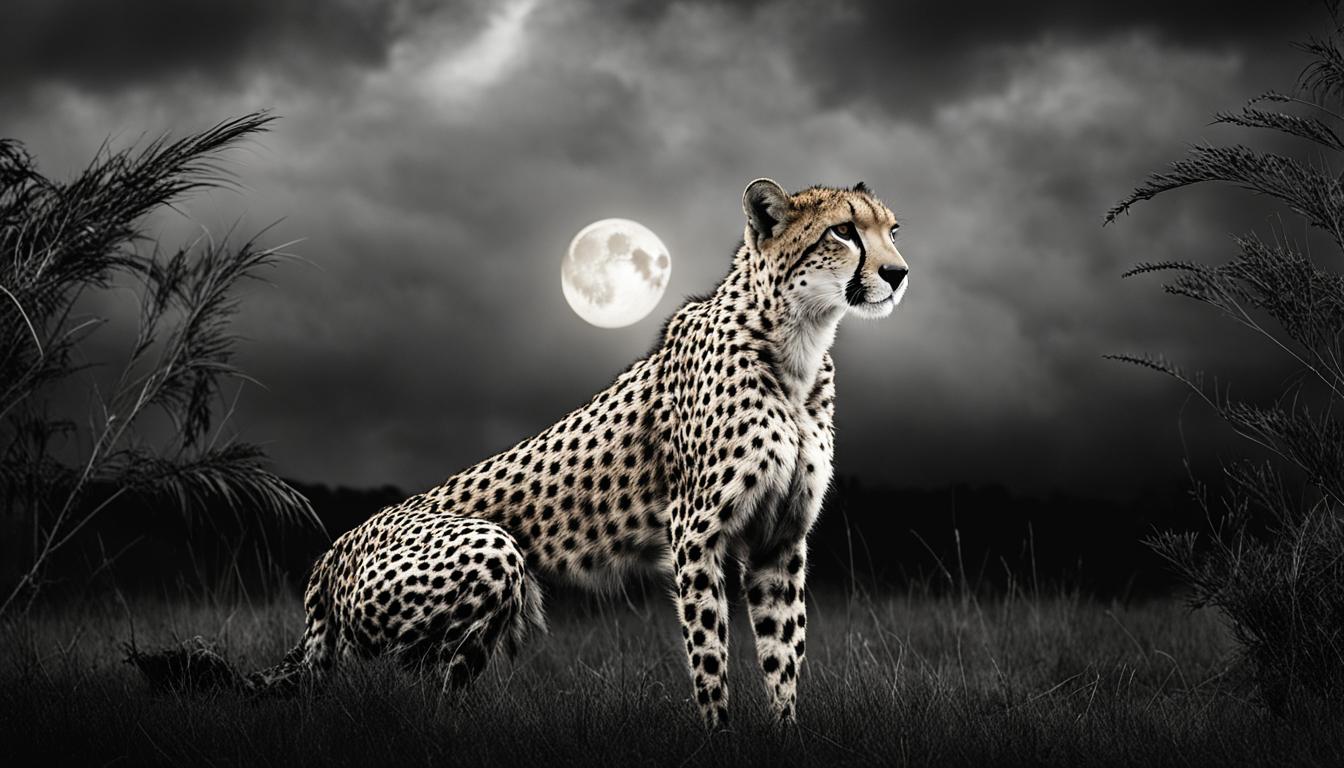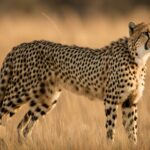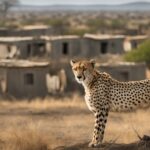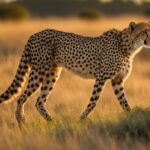When it comes to cheetahs, their exceptional hunting abilities are well-known. However, did you know that these magnificent creatures have fascinating adaptations that allow them to hunt even at night?
Cheetahs are primarily diurnal, meaning they are active during the day. However, they exhibit a unique behavior of adapting their hunting habits as the temperature rises. Instead of braving the scorching heat, cheetahs become more active at dawn and dusk, taking advantage of the lower-light conditions.
This adaptation not only helps cheetahs avoid the intense heat but also allows them to increase their chances of a successful hunt. By becoming more active when their prey is also more active, cheetahs can capitalize on the advantage of surprise.
So, how exactly do cheetahs accomplish these remarkable feats? Let’s explore the various adaptations that enable them to thrive during low-light hunting situations.
| Adaptation | Function |
|---|---|
| Distinct Markings | Reduce glare and potentially camouflage the cheetah |
| Optimized Vision | Wide field of view, enhanced depth perception, and color vision |
| Powerful Claws | Increased traction and grip, assists in sharp turns, tripping prey |
Cheetahs’ Nocturnal Shift
A recent study has shed light on the fascinating behavior of cheetahs, highlighting their ability to adapt their hunting hours in response to changing environmental conditions. Traditionally known as diurnal hunters, cheetahs have been observed shifting their activity patterns to become more active at dawn and dusk, particularly in regions with high temperatures. This adjustment allows them to avoid the scorching heat during the day, making it more comfortable for them to hunt and preserve energy.
This nocturnal shift in hunting behavior, however, brings cheetahs into closer proximity with other larger predators, such as lions and leopards, who are also active during these twilight periods. The increasing overlap between these species during hunting hours raises concerns about potential conflicts and competition for resources. As cheetahs face ongoing challenges due to habitat loss and climate change, this overlap with other predators adds further complexity to their survival.

Climate change, in particular, is impacting cheetah populations by altering the availability of suitable hunting grounds and food sources. Rising temperatures make it increasingly difficult for cheetahs to be active during the daytime, forcing them to adopt more nocturnal hunting behavior. This change disrupts the delicate ecological balance, potentially leading to heightened competition and the displacement of cheetahs from their natural habitats.
The Impact of Climate Change on Cheetahs
With climate change becoming an urgent global concern, the effects on cheetah populations are becoming increasingly evident. As temperatures rise, the range of suitable hunting hours for cheetahs narrows, reducing their chances of successfully hunting and securing enough food. This, in turn, threatens their overall health and reproductive success.
Conservation efforts are crucial to mitigate the impact of climate change and secure a future for cheetahs. Protecting their natural habitats, promoting sustainable practices, and raising awareness about the importance of biodiversity are key elements in preserving cheetah populations for generations to come.
Cheetahs’ Adaptations for Daytime Hunting
Unlike other large cats that primarily hunt at night, cheetahs have evolved specific adaptations that enable them to excel in hunting during the day. These adaptations allow them to effectively navigate their environment and capture their prey with precision.
One of the key adaptations for daytime hunting is the cheetah’s vision. They possess a higher number of cone photoreceptor cells and fewer rod cells in their retinas compared to other cats. This enables them to have enhanced visual acuity and color perception during daylight hours. Their keen eyesight plays a crucial role in spotting and tracking their prey, giving them a significant advantage in the open savannah.
Another important adaptation is the unique tear mark patterns found on the cheetah’s face. These tear marks, combined with the black streaks under their eyes, serve multiple purposes. They not only help reduce glare from the sun, but also improve their focus on their prey by minimizing distractions caused by light reflections. The tear marks may also play a role in social communication, as they are unique to each individual cheetah.
Cheetahs and their Inner Ear Adaptations
In addition to their vision and tear marks, cheetahs have specialized adaptations in their inner ears that contribute to their outstanding hunting abilities. During high-speed chases, cheetahs maintain a unique head posture and gaze stability, allowing them to keep their eyes fixed on their target while their body is in motion. Their inner ear structures provide them with exceptional balance and coordination, enabling them to make precise turns and abrupt changes in direction with minimal loss of speed.
With their finely tuned adaptations for daytime hunting, cheetahs have become efficient predators in their natural habitat. However, it is important to protect and preserve their fragile ecosystem and address the challenges posed by factors such as climate change and habitat loss. By studying and understanding these adaptations, we can work towards ensuring the long-term survival of these magnificent creatures.
| Adaptation | Description |
|---|---|
| Vision | High number of cone photoreceptor cells for enhanced visual acuity and color perception. |
| Tear Marks | Protect against glare and minimize distractions caused by light reflections. |
| Inner Ear Adaptations | Provide exceptional balance and coordination during high-speed chases. |
In conclusion, cheetahs have evolved remarkable adaptations that allow them to thrive in their daytime hunting activities. Their exceptional vision, tear marks, and inner ear adaptations contribute to their success as daytime predators. However, the conservation of cheetahs and their habitats is essential for their survival in the face of increasing environmental challenges. By appreciating and protecting these incredible adaptations, we can help ensure a future where cheetahs continue to roam the savannahs and inspire awe in all who encounter them.
Conclusion
Cheetahs possess remarkable adaptations that allow them to excel in both daytime and low-light hunting conditions. Their exceptional speed, agility, and specialized body features make them formidable predators in the animal kingdom.
However, the survival of cheetah populations is threatened by climate change and habitat loss. It is imperative to prioritize the conservation of their natural habitats and implement strategies to mitigate the impact of climate change.
By safeguarding cheetah habitats, we can help maintain their unique behaviors and ensure a future for these magnificent creatures. Protecting their habitats not only benefits cheetah populations but also contributes to the preservation of biodiversity as a whole.
What are some of the specific adaptations cheetahs have for hunting at night?
Cheetahs have specific cheetahs environment adaptations that make them efficient nighttime hunters. Their large eyes have a high density of rods to enhance vision in low light. Additionally, their sleek bodies and fast reflexes help them navigate and ambush prey in the dark, making them formidable hunters even after the sun sets.
Do Changes in Climate Impact a Cheetah’s Hunting Behavior at Night?
Cheetahs and climate change can indeed impact a cheetah’s hunting behavior at night. As temperatures rise, prey species may alter their behavior, affecting the availability of food for cheetahs. Additionally, extreme weather conditions can make it more challenging for cheetahs to hunt effectively in the dark.
FAQ
How do cheetahs adapt to hunting at night?
Cheetahs are primarily daytime hunters, but when temperatures rise, they become more active at dawn and dusk to avoid the heat. This shift in behavior allows them to hunt during low-light conditions.
What adaptations do cheetahs have for speed and endurance?
Cheetahs have a unique body design that enables them to achieve incredible speeds. Their lightweight skeleton, long leg and foot bones, and highly flexible spine contribute to their rapid acceleration. They also have an enlarged heart, oversize liver, bronchi, and lungs, which provide them with the necessary oxygen intake for high-speed chases. Additionally, they have a higher concentration of “fast twitch” muscle fibers, giving them the power for short bursts of speed.
What adaptations do cheetahs have for hunting?
Cheetahs have distinct markings, including black tear streaks under their eyes, which protect against the sun’s glare and help them focus on their prey. Their eyes are positioned for maximum binocular vision, and they have narrow paws with semi-retractable claws that act like running spikes, providing increased traction while chasing prey. The curved dewclaw on their forelegs is used to trip their prey during a chase.
Why do cheetahs shift their hunting hours to dawn and dusk?
Cheetahs adjust their hunting hours to dawn and dusk when temperatures rise because it becomes too hot for them to be active during the day. This shift increases their overlap with other larger predators such as lions and leopards, leading to potential conflicts.
How do cheetahs adapt to hunting during the day?
Unlike other large cats that primarily hunt at night, cheetahs have adapted to hunting during the day. They have optimized vision for daytime hunting, with more cone photoreceptor cells in their retinas, allowing them to see better in daylight. Cheetahs also have a unique head posture and gaze stability during high-speed chases, thanks to specially adapted structures in their inner ears. The tear mark patterns on their faces help deflect the sun’s glare, improving their visual focus on prey.
What is the impact of climate change on cheetahs’ hunting behavior?
Climate change and habitat loss present significant challenges to cheetah populations. As temperatures continue to rise, cheetahs’ situation could become more critical. Higher temperatures make it too hot for cheetahs to be active during the daytime, increasing the risk of conflicts with larger predators. It is crucial to ensure the conservation of their natural habitats and implement strategies to mitigate the impact of climate change to protect the future of these magnificent creatures.






